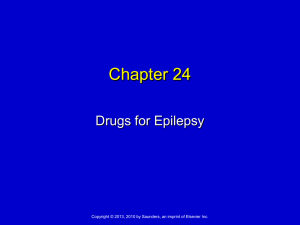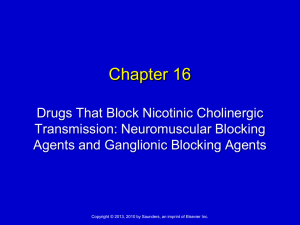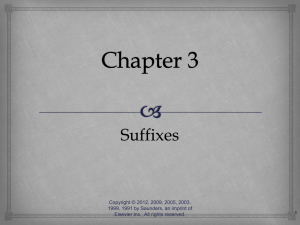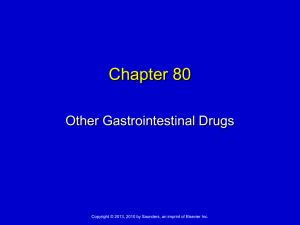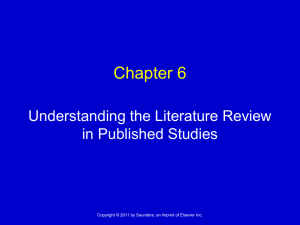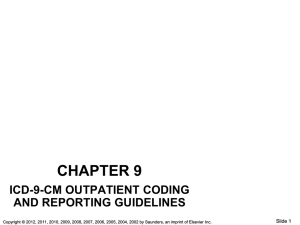Chapter 16 Cholinesterase Inhibitors
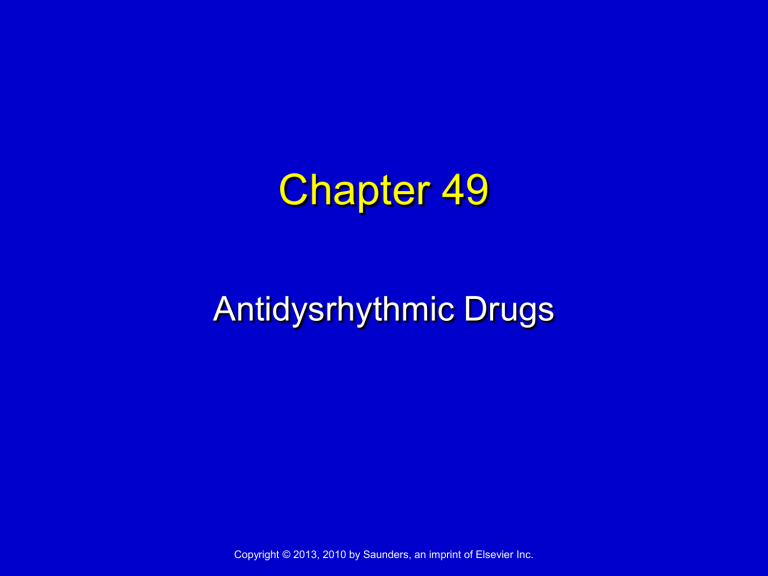
Chapter 49
Antidysrhythmic Drugs
Copyright © 2013, 2010 by Saunders, an imprint of Elsevier Inc.
Dysrhythmia
Dysrhythmia
An abnormality in the rhythm of the heartbeat
(also known as arrhythmias)
Arises from impulse formation disturbances
•
Tachydysrhythmias: SVT and ventricular
•
Bradydysrhythmias
Virtually all drugs that treat dysrhythmias can also cause dysrhythmias
Copyright © 2013, 2010 by Saunders, an imprint of Elsevier Inc.
2
Antidysrhythmic Drugs
Electrical properties of the heart
Generation of dysrhythmias
Classification of antidysrhythmic drugs
Prodysrhythmic effects of antidysrhythmic drugs
Overview of common dysrhythmias and their treatment
Copyright © 2013, 2010 by Saunders, an imprint of Elsevier Inc.
3
Electrical Properties of the Heart
Impulse conduction: pathways and timing
Sinoatrial (SA) node: pacemaker of heart
Atrioventricular (AV) node
His-Purkinje system
Copyright © 2013, 2010 by Saunders, an imprint of Elsevier Inc.
4
Fig. 49
–1. Cardiac conduction pathways.
Copyright © 2013, 2010 by Saunders, an imprint of Elsevier Inc.
5
Cardiac Action Potentials
Fast potentials
Occur in fibers of the His-Purkinje system and in atrial and ventricular muscle
Five distinct phases
•
Phase 0: depolarization
•
Phase 1: (partial) repolarization
•
Phase 2: plateau
•
Phase 3: repolarization
•
Phase 4: stable potential
Copyright © 2013, 2010 by Saunders, an imprint of Elsevier Inc.
6
Cardiac Action Potentials
Slow potentials
Occur in cells of the SA node and AV node
Three features of special significance
•
Phase 0: slow depolarization
Mediated by calcium influx
•
Phases 1, 2, and 3
Phase 1 absent
Phases 2 and 3 not significant
•
Phase 4: depolarization
Copyright © 2013, 2010 by Saunders, an imprint of Elsevier Inc.
7
Fig. 49 –2. Ion fluxes during cardiac action potentials and effects of antidysrhythmic drugs.
Copyright © 2013, 2010 by Saunders, an imprint of Elsevier Inc.
8
The Electrocardiogram
Provides a graphic representation of cardiac electrical activity
Major components of an ECG
P wave
•
Depolarization in the atria
QRS complex
•
Depolarization of the ventricles
T wave
•
Repolarization of the ventricles
Three other components
PR interval
QT interval
ST segment
Copyright © 2013, 2010 by Saunders, an imprint of Elsevier Inc.
9
Fig. 49 –3. The electrocardiogram.
Copyright © 2013, 2010 by Saunders, an imprint of Elsevier Inc.
10
Generation of Dysrhythmias
Two fundamental causes
Disturbances of automaticity
Disturbances of conduction
Atrioventricular block
Reentry (recirculating activation)
Copyright © 2013, 2010 by Saunders, an imprint of Elsevier Inc.
11
Classification of
Antidysrhythmic Drugs
Vaughan Williams classification
Class I: sodium channel blockers
Class II: beta blockers
Class III: potassium channel blockers
Class IV: calcium channel blockers
Other: adenosine, digoxin, and ibutilide
Copyright © 2013, 2010 by Saunders, an imprint of Elsevier Inc.
12
Common Dysrhythmias and Their Treatment
Supraventricular
Impulse arises above the ventricle
Atrial fibrillation
Atrial flutter
Sustained supraventricular tachycardia (SVT)
Copyright © 2013, 2010 by Saunders, an imprint of Elsevier Inc.
13
Common Dysrhythmias and Their Treatment
Ventricular
Sustained ventricular tachycardia
Ventricular fibrillation
Ventricular premature beats
Digoxin-induced ventricular dysrhythmias
Torsades de pointes
Copyright © 2013, 2010 by Saunders, an imprint of Elsevier Inc.
14
Principles of Antidysrhythmic
Drug Therapy
Balancing risks and benefits
Consider properties of dysrhythmias
•
Sustained vs. nonsustained
•
Asymptomatic vs. symptomatic
•
Supraventricular vs. ventricular
Acute and long-term treatment phases
Minimizing risk
Copyright © 2013, 2010 by Saunders, an imprint of Elsevier Inc.
15
Class I: Sodium Channel Blockers
Class IA agents
Class IB agents
Class IC agents
Copyright © 2013, 2010 by Saunders, an imprint of Elsevier Inc.
16
Fig. 49-4. Reentrant activation: mechanism and drug effects.
Copyright © 2013, 2010 by Saunders, an imprint of Elsevier Inc.
17
Class IA Agents
Quinidine
Effects on the heart
•
Blocks sodium channels
•
Slows impulse conduction
•
Delays repolarization
•
Blocks vagal input to the heart
Effects on ECG
•
Widens the QRS complex
•
Prolongs the QT interval
Therapeutic uses
•
Used against supraventricular and ventricular dysrhythmias
Copyright © 2013, 2010 by Saunders, an imprint of Elsevier Inc.
18
Class IA Agents
Quinidine (cont’d)
Adverse effects
•
Diarrhea
•
Cinchonism
•
Cardiotoxicity
•
Arterial embolism
•
Alpha-adrenergic blockade, resulting in hypotension
•
Hypersensitivity reactions
Drug interactions
•
Digoxin
Copyright © 2013, 2010 by Saunders, an imprint of Elsevier Inc.
19
Other Class IA Agents
Procainamide (Procanbid)
Similar to quinidine
Only weakly anticholinergic
Adverse effects: symptoms of systemic lupus erythematosus
Disopyramide (Norpace)
Similar to quinidine
Prominent side effects have limited its use
Copyright © 2013, 2010 by Saunders, an imprint of Elsevier Inc.
20
Class IB Agents
Lidocaine (Xylocaine)
Effects on the heart and ECG
•
Blocks cardiac sodium channels
Slows conduction in the atria, ventricles, and His-Purkinje system
•
Reduces automaticity in the ventricles and His-Purkinje system
•
Accelerates repolarization
Adverse effects
•
CNS effects
•
Drowsiness
•
Confusion
•
Paresthesias
Copyright © 2013, 2010 by Saunders, an imprint of Elsevier Inc.
21
Class IB Agents
Other class IB agents
Phenytoin
•
Antiseizure medication also used to treat digoxin-induced dysrhythmias
Mexiletine
•
Oral analog of lidocaine
•
Used for symptomatic ventricular dysrhythmias
Copyright © 2013, 2010 by Saunders, an imprint of Elsevier Inc.
22
Class IC Agents
Block cardiac sodium channels
Delay ventricular repolarization
All class IC agents can exacerbate existing dysrhythmias and create new ones
Two class IC agents
Flecainide
Propafenone
Copyright © 2013, 2010 by Saunders, an imprint of Elsevier Inc.
23
Class II: Beta Blockers
Beta-adrenergic blocking agents
Only four approved for treating dysrhythmias
1.
Propranolol
2.
Acebutolol
3.
Esmolol
4.
Sotalol
Copyright © 2013, 2010 by Saunders, an imprint of Elsevier Inc.
24
Class II: Beta Blockers
Propranolol (Inderal): nonselective betaadrenergic antagonist
Effects on the heart and ECG
•
Decreased automaticity of the SA node
•
Decreased velocity of conduction through the AV node
•
Decreased myocardial contractility
Therapeutic use
•
Dysrhythmias caused by excessive sympathetic stimulation
•
Supraventricular tachydysrhythmias
Suppression of excessive discharge
Slowing of ventricular rate
Copyright © 2013, 2010 by Saunders, an imprint of Elsevier Inc.
25
Class II: Beta Blockers
Propranolol (Inderal) (cont’d)
Adverse effects
•
Heart block
•
Heart failure
•
AV block
•
Sinus arrest
•
Hypotension
•
Bronchospasm (in asthma patients)
Other class II: beta blockers
Acebutolol (Sectral)
Esmolol (Brevibloc)
Copyright © 2013, 2010 by Saunders, an imprint of Elsevier Inc.
26
Class III: Potassium
Channel Blockers
Amiodarone (Cordarone, Pacerone)
Therapeutic use
•
For life-threatening ventricular dysrhythmias only
•
Recurrent ventricular fibrillation
•
Recurrent hemodynamically unstable ventricular tachycardia
Copyright © 2013, 2010 by Saunders, an imprint of Elsevier Inc.
27
Class III: Potassium
Channel Blockers
Amiodarone (Cordarone, Pacerone) (cont’d)
Effects on the heart and ECG
•
Reduced automaticity in the SA node
•
Reduced contractility
•
Reduced conduction velocity
•
QRS widening
•
Prolongation of the PR and QT intervals
Copyright © 2013, 2010 by Saunders, an imprint of Elsevier Inc.
28
Class III: Potassium
Channel Blockers
Amiodarone (Cordarone, Pacerone) (cont’d)
Adverse effects
•
Protracted half-life
•
Pulmonary toxicity
•
Cardiotoxicity
•
Toxicity in pregnancy and breast-feeding
•
Corneal microdeposits
•
Optic neuropathy
Copyright © 2013, 2010 by Saunders, an imprint of Elsevier Inc.
29
Class III: Potassium
Channel Blockers
Amiodarone (Cordarone, Pacerone) (cont’d)
Drug interactions (increases levels)
•
Quinidine
•
Diltiazem
•
Cyclosporine
•
Digoxin
•
Procainamide
•
Diltiazem
•
Phenytoin
•
Warfarin
•
Lovastatin, simvastatin, atorvastatin
Copyright © 2013, 2010 by Saunders, an imprint of Elsevier Inc.
30
Class III: Potassium
Channel Blockers
Amiodarone levels can be increased by grapefruit juice and by inhibitors of CYP3A4.
Toxicity can result
Amiodarone levels can be reduced by cholestyramine (which decreases amiodarone absorption) and by agents that induce CYP3A4 (eg, St. John’s wort, rifampin)
Copyright © 2013, 2010 by Saunders, an imprint of Elsevier Inc.
31
Class III: Potassium
Channel Blockers
The risk of severe dysrhythmias is increased by diuretics (because they can reduce levels of potassium and magnesium) and by drugs that prolong the QT interval, of which there are many (see Chapter 7)
Combining amiodarone with a beta blocker, verapamil, or diltiazem can lead to excessive slowing of heart rate
Copyright © 2013, 2010 by Saunders, an imprint of Elsevier Inc.
32
Class III: Potassium
Channel Blockers
Dronedarone (Multaq)
Derivative of amiodarone approved in 2009
Effects on the heart and ECG
Pharmacokinetics
Adverse effects
•
Common side effects
•
Cardiac effects in severe heart failure
•
Liver toxicity
•
Toxicity in pregnancy and breast-feeding
Drug interactions
•
Multiple —many involve CYP3A4
Copyright © 2013, 2010 by Saunders, an imprint of Elsevier Inc.
33
Class III: Potassium
Channel Blockers
Sotalol (Betapace)
Combined class II and class III properties
Beta blocker that also delays repolarization
Dofetilide (Tikosyn)
Oral class III antidysrhythmic
Predisposes patient to torsades de pointes
Ibutilide (Covert)
Class III agent
IV agent used to terminate atrial flutter/fibrillation
Copyright © 2013, 2010 by Saunders, an imprint of Elsevier Inc.
34
Class IV: Calcium
Channel Blockers
Verapamil (Calan, Isoptin, Verelan) and diltiazem (Cardizem)
Reduce SA nodal automaticity
Delay AV nodal conduction
Reduce myocardial contractility
Therapeutic uses
•
Slow ventricular rate (atrial fibrillation or atrial flutter)
•
Terminate SVT caused by an AV nodal reentrant circuit
Copyright © 2013, 2010 by Saunders, an imprint of Elsevier Inc.
35
Class IV: Calcium
Channel Blockers
Verapamil (Calan, Isoptin, Verelan) and diltiazem (Cardizem) (cont’d)
Adverse effects
•
Bradycardia
•
Hypotension
•
AV block
•
Heart failure
•
Peripheral edema
•
Constipation
•
Can elevate digoxin levels
•
Increased risk when combined with a beta blocker
Copyright © 2013, 2010 by Saunders, an imprint of Elsevier Inc.
36
Other Antidysrhythmic Drugs
Adenosine (Adenocard)
Effects on the heart and ECG
•
Decreases automaticity in the SA node
•
Slows conduction through the AV node
•
Prolongation of PR interval
Therapeutic use: termination of paroxysmal SVT
Copyright © 2013, 2010 by Saunders, an imprint of Elsevier Inc.
37
Other Antidysrhythmic Drugs
Adenosine (Adenocard) (cont’d)
Adverse effects
•
Sinus bradycardia
•
Dyspnea
•
Hypotension
•
Facial flushing
•
Chest discomfort
Drug interactions
•
Methylxanthines
•
Dipyridamole
Copyright © 2013, 2010 by Saunders, an imprint of Elsevier Inc.
38
Other Antidysrhythmic Drugs
Digoxin (Lanoxin)
Primary indication is heart failure
Also used to treat supraventricular dysrhythmias
(inactive against ventricular dysrhythmias)
•
Suppresses dysrhythmias by decreasing conduction through AV node and automaticity in the SA node
•
QT interval may be shortened
Adverse effect: cardiotoxicity
•
Risk increased by hypokalemia
Copyright © 2013, 2010 by Saunders, an imprint of Elsevier Inc.
39
Nondrug Treatment of Dysrhythmias
Implantable cardioverter-defibrillators
Radiofrequency catheter ablation
Copyright © 2013, 2010 by Saunders, an imprint of Elsevier Inc.
40
